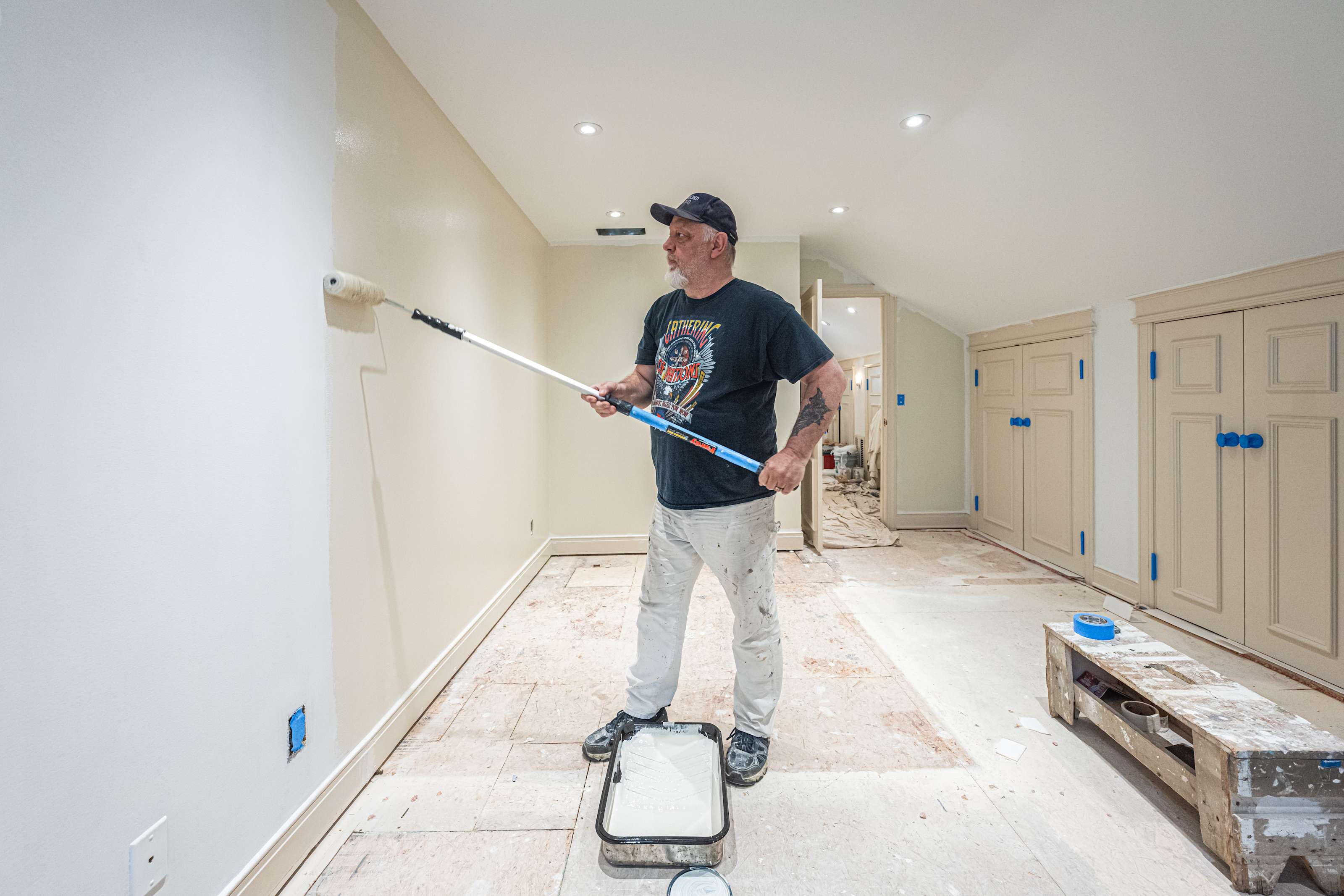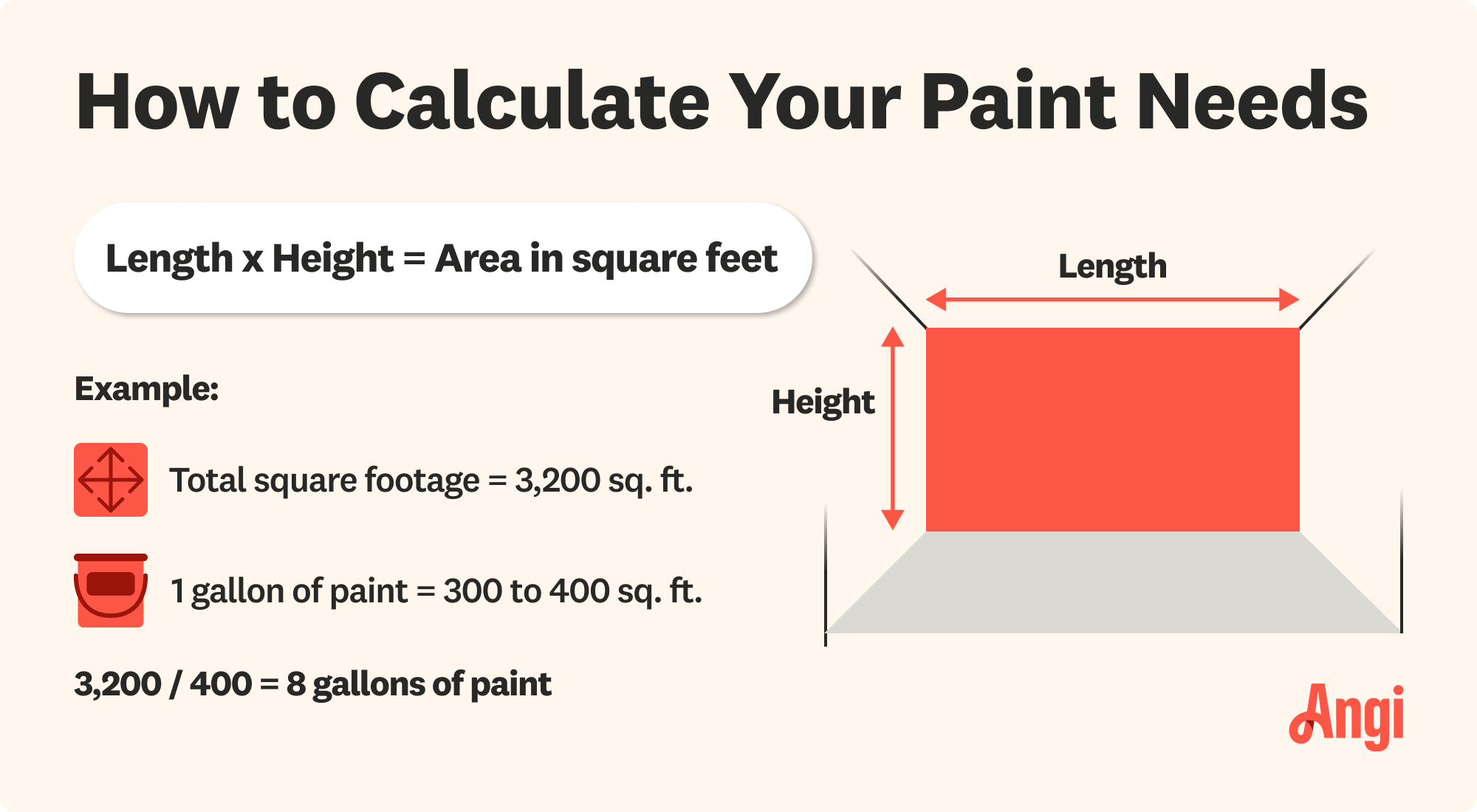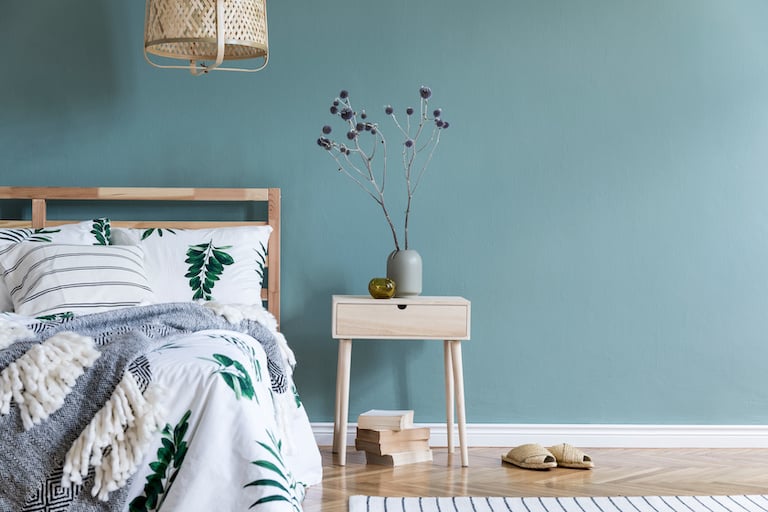
The cost to paint the interior of a house in Baltimore, MD depends on size, layout, type of surface, and more. Learn what factors can influence your total in this guide.
The cost to paint a room averages around $1,100, and most homeowners pay between $400 to $1,600, depending on the room size, ceiling height, and more.


Professionals charge $2 to $6 per square foot for interior painting.
The main cost factors are room size and the paint type you choose.
Baseboards, trim, intricate designs, and extra paint coats will raise your cost.
The average cost to paint a room is around $1,100, and prices range from $200 to $2,000. Your exact cost depends on the room size, the paint you choose, the number of paint coats, who you hire, and more. Pros charge $2 to $6 per square foot of space, so you can use those numbers to estimate your total.
A modest-sized room of around 100 square feet will cost between $200 and $600 to paint, whereas a larger room of around 250 square feet will cost $500 to $1,500. Factors like room layout and wall height will influence what you pay.
Interior painting offers a high ROI of around 107%. That means that most homeowners will recoup between $2,100 and $16,000, depending on the size of their painting project. Neutral colors are more appealing to potential buyers than darker colors.
For most homeowners, painting the interior of a home costs anywhere from $975 to $3,100, but a single room is much more affordable. It depends on factors like the size of the room to the quality and type of paint. Even something as seemingly inconsequential as a finish can add a few extra bucks to the budget. Here’s how the costs break down.
Professional interior paint jobs are priced at $2 to $6 per square foot in most cases. The larger the room, the higher the cost—especially if you have tall ceilings that are difficult to reach. If you know the square footage of your room, you can use these numbers to get a fairly accurate estimate for your paint job.
| Room Size (Feet) | Average Cost to Paint |
|---|---|
| 10X10 | $200–$600 |
| 10X12 | $240–$720 |
| 12X12 | $290–$870 |
| 14X16 | $450–$1,350 |
| 16X16 | $515–$1,540 |
Another cost factor to consider when painting a room is its ceiling height. If you have high or difficult-to-reach ceilings, you can expect to pay an additional fee for labor and materials. Painting a ceiling costs an extra $1 to $6 per square foot, depending on the ceiling type and the painter’s rates.
You’ll pay the most for cathedral ceilings that reach above 12 feet, while a 10-foot ceiling will only add around $1 per square foot to paint, as they don’t require any scaffolding or special equipment.
The price of your painting project depends on the type of room in question. Bathrooms are the smallest room in the house and the least expensive to paint while painting living rooms is the most costly. Keep in mind that some larger rooms, like kitchens, can be inexpensive to paint because a large portion of the walls is covered by cabinets or backsplashes.
| Type of Room | Average Cost to Paint |
|---|---|
| Bathroom | $200–$400 |
| Kitchen | $300–$750 |
| Stairway | $350–$450 |
| Bedroom | $300–$750 |
| Living Room | $900–$2,000 |
Want to refresh your trim and baseboard paint? Giving home accents like trim, baseboards, crown molding, and windows a fresh coat of paint will cost about $1 to $3 per linear foot.
Keep in mind that professional painters may charge extra for hard-to-reach accents, up to $6 per linear foot. Particularly ornate trim can also be a bit more expensive to paint if there are a lot of nooks and crannies your professional will have to cover.
Paint costs depend on brand, makeup, and finish. On average, you’ll pay $20 to $70 per gallon, and each gallon covers between 300 and 400 square feet. You can get a budget-friendly option from a big box retailer for as little as $10 per gallon or spend more than $100 per gallon on a designer brand or rare pigment.
| Latex-Based Paint | Oil-Based Paint |
|---|---|
| $15–$60 per gallon | $20–$70 per gallon |
| Best for bedrooms, living rooms, and hallways | Best for bathrooms, kitchens, doors, and trim |
| More difficult to clean | Easy to clean and holds up well to moisture |
| Dries faster | Prone to chipping and requires good ventilation |
Overall, oil-based paints cost slightly more than latex-based paints (though latex is by far the most popular for indoor use). On top of that, you’ll pay more the glossier the finish gets. Paint durability and moisture resistance also increase as the finish gets glossier, so it’s wise to consider the area you’re painting and not to shop solely on cost. Note that prepwork varies among the different types of paint, too.
| Paint Type | Cost per Gallon |
|---|---|
| Primer | $10–$20 |
| Flat or matte | $10–$70 |
| Eggshell or satin | $10–$70 |
| Semi-gloss | $10–$70 |
| High-gloss | $20–$80 |
The number of coats you need is an important consideration, as each additional coat will require more material and significantly increase your labor costs if you’re hiring a professional painter.
If your walls were previously a dark color and you’re now using a lighter color, you’ll likely need additional coats to get total coverage and avoid the darker color underneath from showing through. Each additional coat will cost you an average of $50 to $70 per 300 to 400 square feet of wall, so the cost of additional coats can quickly add up. If you’re hiring a painter, the extra coats of paint will increase both material and labor costs.
If you’re choosing an accent wall to add some depth to your room, the cost of labor will increase, as your professional will need to tape off the wall and paint it separately from the rest of the room.
If you decide to pay a house painter to paint your room, you can expect to spend $20 to $50 per hour. The cost to hire a handyman to paint a room will sit a bit lower, often between $20 and $40 per hour.
Most painting contractors quote this job on a per-square-foot basis instead of charging by the hour, and it’s standard for between 60% and 90% of the total to go toward labor. That’s an average of between $240 and $1,450 on labor alone. Labor costs can go up if you have particularly high ceilings, a complicated floor plan, or other needs that make your paint job take longer.
You may need to move furniture out of the room you want to paint. In this case, your contractor will spend some extra time on prep, so it can slightly increase costs. If you have oversized furniture (think: a grand piano or grandfather clock), it might take an additional worker to move. Expect to spend $25 to $50 per hour on additional labor (though the cost will likely be wrapped into your per-square-foot estimate).
Wall texture can transform the feeling of a room—whether it’s a combed texture, sand swirl, or orange peel. It’s not everyone’s cup of tea, though some homeowners love it. Expect to spend a couple of dollars extra per square foot if you want to add or remove wall texture before the painting process:
The cost of texturing your walls is $1 to $3 per square foot
The cost of skim coating drywall to remove texture is $1.10 to $1.30 per square foot
You may need to repair your walls before you can paint them, especially if you have water damage or cracked or peeling paint on your walls. The cost of drywall repair typically falls between $300 and $900, with an average of around $600. Alternatively, you can DIY small repairs with a drywall repair kit, which costs $10 to $30.
Fall and winter are the slowest months for painting companies because there are fewer exterior paint jobs. You can often save money by booking your contractor for an interior paint job during the offseason.
Lead paint and asbestos are common in homes built before 1980, and they require special care to remove. If testing finds lead or asbestos, you’ll spend more on abatement. If your contractor needs to remove paint or alter the drywall, you might need to test it first for lead or asbestos:
A lead inspection costs $200 to $400, though a lead risk assessment can cost up to $2,000.
An asbestos survey costs $230 to $780.
Labor costs vary widely based on the local cost of living, and since the cost to paint a room largely goes toward labor, your cost will depend quite a bit on your location. Large metropolitan areas with higher costs of living will usually be more expensive, as will states with an above-average cost of living.
| State | Cost to Paint a Room |
|---|---|
| California | $1,570 |
| Florida | $1,130 |
| Georgia | $1,000 |
| Illinois | $1,040 |
| Michigan | $1,000 |
| New York | $1,360 |
| North Carolina | $1,070 |
| Ohio | $1,030 |
| Pennsylvania | $1,050 |
| Texas | $1,010 |

So, you’re ready to breathe new life into your room? The next step is figuring out how to calculate the cost of painting a home interior.
1. To start, use a tape measure and write down the length of all four sides of the room.
2. Then, measure the height of the walls from the floor to the ceiling.
3. Next, add up the lengths of the room and multiply it by the height. That gives you the total square footage you need to paint.
4. On average, one gallon of paint can cover 300 to 400 square feet. So divide the total square footage of your room by 400 to find out how many gallons of paint you need for one coat.
5. In most cases, you’ll apply two coats of paint, so multiply that number by two.
If you plan on hiring a pro to do the job, expect to pay $20 to $50 per hour for labor. Some painters will quote you based on square footage, so doing this math can help you get the most accurate quote.

Most of the cost for interior painting will go toward labor, so DIYing can cost under $100 in materials, depending on the size of the room. However, hiring an interior painter near you is still often worthwhile because prepping and painting walls is very time-consuming, and professionals will normally get a nicer finished look that’s free of mistakes. Pros can also get the job done more quickly, so there’s less interruption to your daily routine.
Painting a room is absolutely DIYable, but there are a few important benefits of hiring a pro that you should consider before you decide to tackle the project yourself:
Professionals almost always get a better look with crisp lines and no mistakes.
Pros have a high skill level that makes painting lines along trim, ceilings, and cabinets faster and more accurate.
Some painting jobs can be dangerous if they involve ladders or scaffolding, so hiring a pro can keep you safe.
Interior painting can take a long time to DIY, while a pro can have you back to your normal routine in a day or two.
Painters may offer a warranty for their work and even provide free touch-ups for a certain period after the job is done.
While you’re budgeting for a room refresh, you may want to consider the following add-on costs to get everything done at once and potentially save some money on the total.
Cost to remove wallpaper: $420 to $1,200
Cost to refinish floors: $1,100 to $2,700
Cost to replace light fixtures: $150 to $1,000
Cost to repair drywall: $300 to $920
Cost to replace windows: $3,400 to $11,800
Cost to paint an accent wall: $700 to $1,800
Want to tighten your budget and cut down on the cost to paint rooms? Saving on a painting job doesn’t necessarily mean you’ll have to roll up your sleeves and do it yourself—though if you’ve got a passion for DIY projects, go for it! Here are some ways to shed a few dollars off your total painting costs:
Skip the trim refresh: If the paint on your trim, baseboards, and ceiling is in good condition and you simply want to change the look of your room, only paint the walls. Going this route will often cut your total price in half.
Purchase paint through your pro painter: If you’re using a contractor to paint your home, let them purchase the paint. Contractors can sometimes buy paint for around 50% less than a homeowner, so the total included in your painting estimate should be significantly lower.
Skip the designer materials: Like clothes, designer paints cost much more, but you’re paying for quality and vibrancy. These paints use natural coloring agents that look more vibrant than synthetic pigments. Nonetheless, you can still get some great colors by choosing a high-quality paint without the luxury label.
Mention the size of your room, the general layout, and the ceiling height to your pro to get an accurate estimate.
Be prepared to discuss any add-on work you need, like drywall repairs, trim painting, and ceiling painting.
Ask what brands of paint your pro recommends, or mention a type that you prefer to use.
Be prepared to talk about paint finishes, which can affect material costs and even application methods.
Home is the most important place on earth, which is why Angi has helped more than 150 million homeowners transform their houses into homes they adore. To help homeowners with their next project, Angi provides readers with the most accurate cost data and upholds strict editorial standards. We extensively research project costs to develop the pricing data you see, so you can make the best decisions for you and your home. We rely on reputable sources, including the U.S. Bureau of Labor Statistics, academic journals, market studies, and interviews with industry experts—all to ensure our prices reflect real-world projects.
Want to help us improve our cost data? Send us a recent project quote to [email protected]. Quotes and personal information will not be shared publicly.
From average costs to expert advice, get all the answers you need to get your job done.

The cost to paint the interior of a house in Baltimore, MD depends on size, layout, type of surface, and more. Learn what factors can influence your total in this guide.

The cost to paint the interior of a house in Columbus, OH depends on size, layout, type of surface, and more. Learn what factors can influence your total in this guide.

The cost to paint the interior of a house in Seattle, WA depends on size, layout, type of surface, and more. Learn what factors can influence your total in this guide.

Painting can be a tedious job, but it all comes down to the tools you use. Learn whether it’s better to use a paint sprayer or roller to get the job done.

From stone, tile, wallpaper, or paint, discover different accent wall ideas for your space.

No one wants a bathroom with peeling paint and mold buildup. Picking the best paint for bathrooms helps you steer clear of these shower room setbacks.